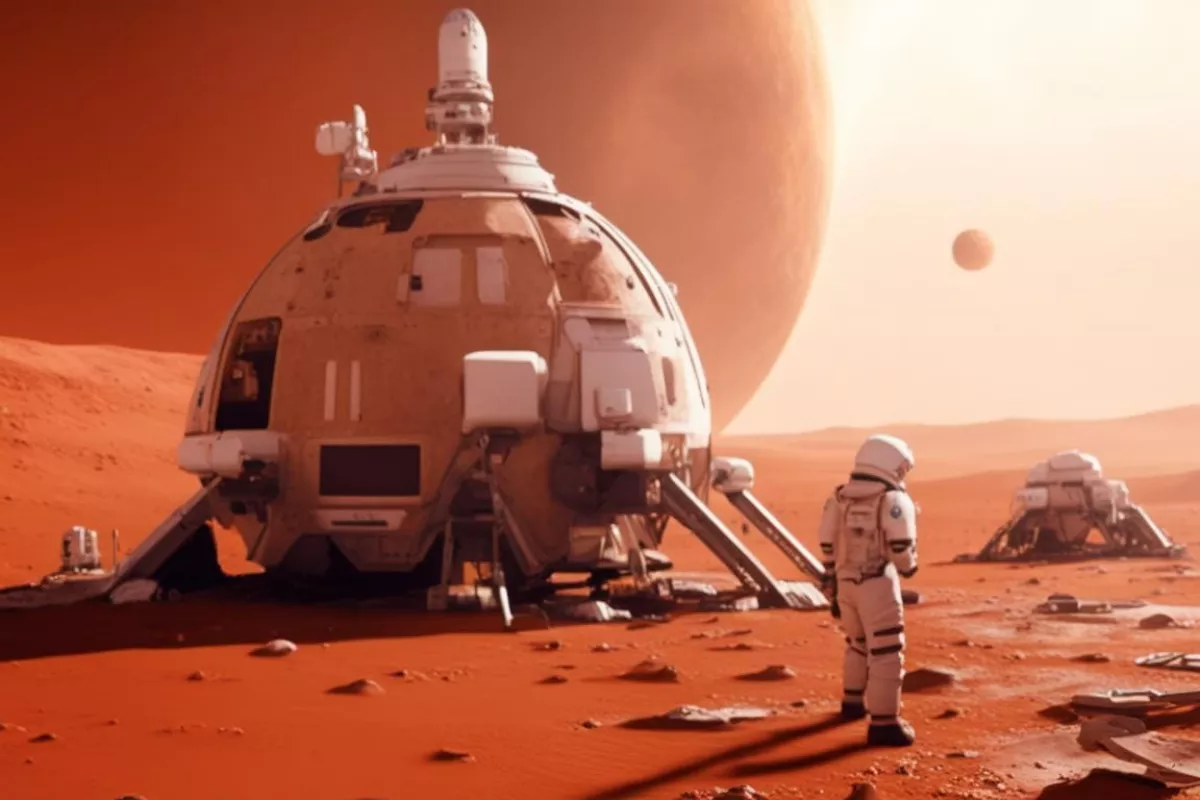USA vs. China: The race for colonizing Mars Who will plant the flag first?
Who will set foot on Mars first — China or the United States? And what role does Donald Trump play in the race for the Red Planet? Both space superpowers had initially set their target dates for Mars expeditions around the 2030s. But with Donald Trump’s return to power, could this timeline accelerate?
A soft landing on Mars
Mars is one of the few planets in our solar system where scientists believe life may have existed in the past. Some theories even suggest that microbial life could still exist there today. Research on the Red Planet may hold the key to solving one of humanity’s greatest mysteries: the origin of life on Earth. Moreover, the boldest visionaries are already considering the potential for future colonization of Mars by humans.
In December 1971, the descent module of the Soviet automatic interplanetary station (AMS) Mars-3 made history as the first spacecraft to achieve a soft landing on Mars. However, just 14.5 seconds after its parachute-assisted descent, the transmission from Mars to Earth was abruptly cut off as the spacecraft ceased functioning for reasons still unknown.
Since then, American, Soviet, and Chinese spacecraft have carried out several more landings on Mars. Yet, the Red Planet is far from hospitable—its name, inspired by the god of war, seems fitting. To date, 22 missions to Mars launched by the USSR/Russia, the United States, the European Union, China, and Japan have ended in failure.

The first wave of Mars missions occurred in the 1970s, driven not only by scientific curiosity but also by the ideological competition between the USSR and the United States. In the 1980s, there was only one attempt to land on the Red Planet — the Soviet Phobos mission in 1989.
The 1990s saw two expeditions to Mars, both launched by the United States. However, starting in the 2000s, there has been a marked increase in Mars exploration activity. Today, rovers are actively conducting operations on the distant planet, including the exploration of its mineral resources.
Will there be life on Mars?
Today, the agenda has shifted toward the ambitious goal of landing humans on Mars. This objective has fueled a "Martian" competition between the world’s two superpowers — China and the United States.
In the U.S., lunar and Martian missions are being spearheaded by NASA, utilizing the Orion spacecraft and the heavy-lift Space Launch System (SLS) rocket. However, the private sector has also joined the race, led by Elon Musk's SpaceX, which has been making significant strides in the field. Musk’s Martian program frequently captures media attention.
Reducing the cost of Mars missions has been a critical challenge, and SpaceX has addressed this by developing the reusable Starship rocket. Comprising a super-heavy booster and the spacecraft itself, Starship can transport up to 100 tons of cargo or 100 passengers in a single trip. The booster is designed to return vertically to Earth, while the spacecraft is also intended to land intact.
In November this year, Elon Musk personally showcased this landing concept to Donald Trump using a model of the rocket during the President-elect’s visit to the Texas launch site.
The Starship is made from stainless steel, unlike many other spacecraft, which are typically constructed using aluminum alloys or composites. SpaceX believes stainless steel offers significant advantages, including heat resistance—essential for re-entry into dense atmospheric layers—as well as cost efficiency and ease of fabrication.
The Starship also features the Raptor engine, which employs a full-flow staged combustion cycle and runs on methane. Most other rockets use kerosene or liquid hydrogen as fuel. The choice of methane is strategic: SpaceX engineers plan to refuel Starship directly on Mars by synthesizing methane from carbon dioxide in the planet's atmosphere and water extracted from Martian underground ice.
These features clearly indicate that Starship is designed not just to reach the surface of the Moon or Mars but to support the long-term colonization of distant planets. Colonizing the Red Planet is Elon Musk’s ultimate "fixation." Initially, the plan involves establishing a base on Mars with essential infrastructure, including solar panels and life-support systems. The next step will bring the first astronauts to the planet, where greenhouses will be set up, and the groundwork for building a self-sustaining city with a population of one million will begin.
However, the project is far from simple, and there are many questions surrounding it. For example, the spacecraft will undergo enormous stress during the expedition, and it remains unclear how many flights it will be able to handle. Additionally, the months-long journey to Mars poses significant health risks for astronauts, making the development of adequate radiation and thermal protection crucial.
Between 2022 and 2024, Musk’s company conducted six successful orbital flights, but from 2019 to 2021, at least six Starship test flights ended in explosions.

The immense difficulties are reflected in the repeated delays of the crewed interplanetary flight. Musk’s initial plans called for the first human mission to Mars to take place in 2024, but the launch was then rescheduled for 2026. The timeline has since been pushed further, with the mission now set for 2031. Besides the challenges in preparation, Mars missions also depend on a two-year "window"—the most optimal time for a flight to Mars occurs once every 26 months.
Recently, however, Elon Musk stated that his company plans to launch five uncrewed Mars missions in the next two years. If all goes well, a crewed expedition could depart as early as 2028.
Musk, Trump, and Mars
It is clear that Elon Musk has high hopes for the recently elected president, Donald Trump, in his Martian endeavor. Interestingly, Musk had previously been quite critical of Trump. Their relationship has been complex; in 2020, Trump referred to Musk as “one of our great geniuses” and compared him to Thomas Edison. However, by 2022, Musk faced a harsh tirade from Trump.
In July 2024, Musk announced his support for Trump’s presidential candidacy. In September, at a campaign rally in North Carolina, Trump said, “Elon, get those rocket ships going, because we want to reach Mars before the end of my term!” At a rally in Pennsylvania, where Musk joined him, the Republican candidate declared, “we’re going to win, and he’s going to reach Mars by the end of our term, which is a big thing. Before China, before anybody, right? And I — my money’s on that guy right there.”
On November 25, the elected U.S. president, Donald Trump, attended the sixth Starship launch in Texas, which took place a month after the fifth test flight. However, due to technical issues, the crucial component of the test—catching the heavy booster during landing using giant "arms" nicknamed "chopsticks"—was not carried out.

During Trump’s upcoming term, up to 400 Starship launches are planned. SpaceX’s efforts in the Martian project are also supported by NASA. On December 6, it was reported that Trump is considering Jared Isaacman, a businessman close to Musk and a shareholder in SpaceX, for the role of NASA administrator. Isaacman may also head the committee responsible for certifying Starship for lunar and Martian missions.
Moreover, during his first presidential term, Trump established the U.S. Space Force and promised to create a Space National Guard.
At the same time, Elon Musk has accused government agencies of hindering his Martian projects, citing restrictions on rocket testing due to environmental concerns. He has also pledged that his newly formed Department of Government Efficiency will address the issue of government regulation.
Quietly, but steadily, NASA continues its preparations for a crewed mission to Mars under the Artemis program. In July of this year, four volunteer testers completed the 378-day CHAPEA mission, which simulated life on the Red Planet under conditions of complete isolation. One of the key stages of NASA's Mars program is the creation of a permanent station on the Moon. Oxygen is planned to be extracted from the Martian atmosphere, and research is also underway on growing food crops in space.
Mars' dust storms, which can last for months, make solar power unreliable, so nuclear reactors are being favored as a more stable energy source. Additionally, communication with Earth is expected to be maintained through laser technologies. NASA initially aimed to land humans on Mars in the 2030s.
The "Celestial Empire – Mars" space ladder
In November 2019, China announced its plans for crewed missions to Mars. However, the mission to Mars will be preceded by a Chinese landing on the Moon. In 2021, China successfully landed its Mars rover Zhurong on the Red Planet.
According to Wang Xiaojun, Director of the China Academy of Launch Vehicle Technology, speaking at the Global Space Exploration Conference (GLEX 2021), China’s Mars mission will be carried out in three stages. In the first stage, unmanned spacecraft will be sent to Mars to explore potential sites for a Martian base, collect soil samples, and return to Earth. The construction of a permanent base on Mars, utilizing the planet’s resources, will involve robots, with plans to extract water from underground, synthesize oxygen, and generate electricity.
The second stage will involve a crewed mission to Mars. The third stage will focus on large-scale colonization of Mars, with cargo fleets regularly traveling between Earth and Mars. In this phase, Mars flights are expected to become routine. The primary option under consideration involves rockets powered by nuclear fuel. The Chang Zheng-9 heavy-lift rocket, designed for this purpose, will be capable of carrying up to 133 tons of payload to low Earth orbit and up to 50 tons to geostationary orbit. Its first launch is expected in 2028.

In China, there is also serious research into a radically different concept—the interplanetary transportation system known as "Sky Ladder," which could significantly reduce the cost of transporting people and cargo into space. The Xinhua News Agency has showcased computer-generated images of how this might look: a passenger or cargo capsule would travel along a "ladder" made of carbon nanotubes. The capsule would move from one space station to another, eventually reaching the Moon, and then continue along the "space ladder" steps to Mars.
When will the red flag of China be raised on the Red Planet? In 2030, China plans to conduct an unmanned research mission to Mars. The first crewed mission is expected to take place in 2033. By 2043, China intends to complete five crewed missions to Mars.
In addition to the USA and China, Russia, India, and the EU are also developing their own lunar and Mars exploration projects. There is even the possibility of an international mission to Mars based on a collaborative effort.
So, who will be the first? The USA has made significant advancements in space technologies, theoretically enabling crewed interplanetary flights. China initially had to catch up with the USSR/Russia and the United States in space exploration, but its rapidly growing pace suggests major successes in this field. However, China is not rushing into the Mars race and is not aiming to be first in terms of timing. Americans, true to their competitive spirit, are eager to lead the way. Yet, haste—especially in space exploration—can bring about problems and setbacks. As a Chinese proverb wisely states, “Live in peace. When the time comes, the flowers will bloom on their own…”








